They say… 
Best beer and travel writing award 2015, 2011 -- British Guild of Beer Writers Awards
Accredited Beer Sommelier
Writer of "Probably the best book about beer in London" - Londonist
"A necessity if you're a beer geek travelling to London town" - Beer Advocate
"A joy to read" - Roger Protz
"Very authoritative" - Tim Webb.
"One of the top beer writers in the UK" - Mark Dredge.
"A beer guru" - Popbitch.

|
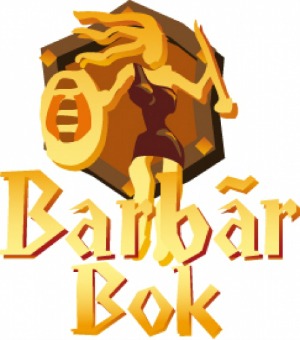 Lefebvre Barbãr (Winter) Bok ABV: 8%
Origin: Quenast, Brabant-Wallonie, Wallonia
Website: www.brasserielefebvre.be
First published: 5 February 2001
Another review from the archive written for the pioneering Oxford Bottled Beer Database (OBBD). I’ve left it uncorrected — so please read it in that historical spirit. At the time the beer was was 8% ABV, and also known as Barbãr de Noël: it’s now 8.5% and simply known as Bok, and though available for a longer season is still a winter speciality.
This is the dark, winter version of Lefebvre’s bottle-conditioned honey beer Barbãr, brewed from October to February and described on the bottle as ‘the winter sleep of the warrior’. The gravity is enough to send anyone to sleep unless treated with care, even the stylised prehistoric warrior queen figure depicted on the label.
The beer is almost black, with a nice rich head, and a very scented, honeysuckle-like, slightly phenolic aroma, perhaps with some Styrian hops. The texture is smooth and honeyed, and the floweriness continues into the taste, which has hints of dandelion and burdock and rich liquorice flavours.
A splash of sweetness then develops, followed by a quite citric hoppiness and a slightly chocolatey finish. It’s a pleasant and perilously drinkable beer that somewhat resembles Hoegaarden’s Verboden Vrucht, though without the latter’s complexity, length and marmaladey denseness.
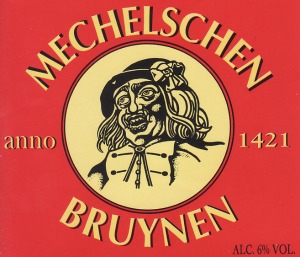 Het Anker Mechelschen Bruynen ABV: 6%
Origin: Mechelen, Antwerpen, Flanders
Website: www.hetanker.be
First published: 22 January 2001
Another review from the archive written for the pioneering Oxford Bottled Beer Database (OBBD). I’ve left it uncorrected — so please read it in that historical spirit. Sadly this is one of the historic beers since retired by its brewery. I don’t think I was quite accurate in likening it to the East Flemish brown ale style: more likely it was a late 20th century invention ‘inspired’ by earlier brown ales.
The Anchor brewery in Mechelen, former capital of Brabant, is best known for Gouden Carolus/Carolus d’Or, a sweet, strong speciality. This beer is the brewery’s more everyday brown ale, but it still boasts a respectable gravity and is somewhat special in its own right. The archaic spelling and grammar of the name indicates an old-style brew, and this bottle-conditioned beer is broadly in the ultra-traditional style of the brown ales of East Flanders typified by Liefmans, rather than their sourer, West Flanders counterparts.
It’s very aromatic, scented with violets, roses and spices, and an invitingly deep ruby brown colour, with a lively condition. The palate is full and malty, still slightly flowery and with hints of phenol, ending in a tangy finish with plenty of distinct hops that have kindly waited their turn to allow the malt to assert itself.
The beer has something of the candyish quality of its more famous stronger stablemate, and the finish is a beautiful balancing act that just lifts it enough. A ‘must-have’ for brown ale fans and well worth seeking out for everyone else too.
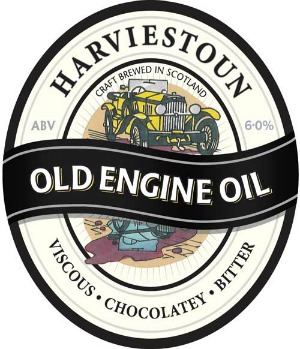 Harviestoun Old Engine Oil ABV: 6%
Origin: Alva, Clackmannanshire, Scotland
Website: www.harviestoun.com
First published: 8 January 2001
Another review from the archive written for the pioneering Oxford Bottled Beer Database (OBBD). I’ve left it uncorrected — so please read it in that historical spirit.
Old Engine Oil hadn’t been around very long when I wrote this review: although based on an old porter recipe, it was devised for the first ever Tesco Beer Challenge in 2000, which it won. Unlike many other winners of that competition, it’s still one of its brewery’s best known beers today, despite my reservations about its name. Over the years since, Harviestoun, founded in 1986, has been part of a bigger group (Caledonian and briefly Scottish Courage/Heineken) then once again independent, and if anything is regarded even more highly now than in 2001. The beer has been available in a variety of strengths including a cask version at 4.5%.
Another speciality thrown up by Tesco supermarket’s Beer Challenge, this apparently won the Winter 2000 competition. Since it’s an unusual but very pleasant beer, this fact is easy to understand; what’s harder to fathom is the mindset of the marketing bods that first gave it such an unattractive name and then tried to claim that it’s “derived from a traditional Celtic recipe”!
Its only resemblance to old engine oil is its colour: it’s dark almost to the point of ebony, with ruby highlights in the light. It’s not bottle-conditioned but pours lively, with little head, giving off scents of liquorice and chocolate. The palate is full and malty, with dark burnt fruits and the promised liquorice and chocolate in abundance, with a slightly wine-gum-like quality offset by a bracing coffeish hop bitterness.
The finish is dry and tangy with hints of strawberry fruit. A welcome new departure for a brewery known for their lightness of touch, it’s a difficult beer to classify, with many of the flavours of a stout but the texture and drinkability of an ‘old peculier’-type ale. Far too good to waste on an engine.
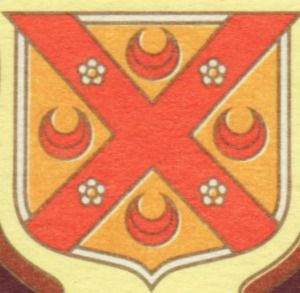 Castle Eden brewery ABV: 5.5%
Origin: Castle Eden, Durham, England
Website: www.cameronsbrewery.com
First published: 8 January 2001
Another review from the archive written for the pioneering Oxford Bottled Beer Database (OBBD). I’ve left it uncorrected — so please read it in that historical spirit. For more about Castle Eden and what happened to it, see the introduction to my review of Castle Eden Special Ale.
The beer challenge run by the Tesco supermarket chain continues to put interesting and imaginative British beers on the shelves. Durham-based Castle Eden apparently got commended for this beer, described as “dark amber coloured with a clever twist of orange”, in the Autumn 2000 competition. Flavouring beer with orange is such a clever idea lots of other brewers have thought of it, but this brew, which is not bottle-conditioned, turns out to be a paler colour than “dark amber” might suggest.
There’s a lovely initial bouquet of flowery hops, summery fresh orange peel and, more distantly, fresh varnish and mown grass. In the mouth the orange-peel flavours are underlined by a certain oiliness of texture, making it very smooth on the tongue; underneath the aromatic fireworks is good pale malt and a late-emerging hoppy edge to give a tangy swallow and a moderately sustained tangy-fruity finish.
Some British beers taste of oranges anyway – usually in the form of dark marmalade, but the refreshingly light and zingy orange here is unusually effective, even if ‘clever’ isn’t quite the right adjective.
 “Discount slabs of bland lager.” As I began my beer-writing career with bottle reviews, some of the earliest features I was asked to write were on the subject of the bottled beer trade in general. For the sake of completeness, I’m reproducing this short piece written for Fuller’s Fine Ale Newsletter in 2007. Not much has changed on the supermarket side, and if Real Ale in a Bottle as a category really is a “sleeping giant”, it’s still snoring loudly. But I was prescient in noticing the diversifying routes to market for microbrewed beers. The one outlet that didn’t seem so much of a factor back then was the taproom and brewery shop, which for many new breweries has since proved a vital way of cutting out the middleman.
Back in the 1970s, buying beer to drink at home meant going to a closeted-off corner of the local pub and choosing between the owning brewery’s light, pale and brown ales in thick half-pint deposit bottles. If you were lucky you might also be offered similarly packaged specimens of Mackeson, Guinness and White Shield, plus Gold Label rationed by the third-pint “nip”.
80% of beer sales back then were on-sales, and the consumption of alcohol outside the confines of a pub still carried a social stigma. While it was fine to pick up a stout or barley wine for Granny who didn’t get out much, or head off to a social gathering armed with that retro style icon, the Party Seven, anything else might be viewed as problem drinking.
The intervening decades have seen a huge change in attitudes and consumption patterns. Against a trend of overall decline in beer sales in the UK, off-trade sales now stand at 40% and rising. But the dingy off-license entrances are no more, and the recent news that Scottish Courage [update: now part of Heineken] are withdrawing Newcastle Brown in old-style deposit bottles demonstrates the insignificance of the pub when it comes to carry-out.
Instead, the growth is mainly down to the big supermarkets with their price cutting and marketing clout. And while discount slabs of bland lager make up the bulk of their volume, the supermarkets have also played a major role in flattering the beer drinker as a connoisseur, much as they previously drove the democratisation of wine appreciation and helped make boozing at home respectable. Specialist beer ranges sit alongside organic, “finest” and locally sourced products in their appeal to the more discerning shopper with money to spend on expensive – and profitable – items elsewhere in the store.
Still, supermarket beer has its limits. Listings are often achieved through the ability to offer deep discounts so the same brands crop up again and again. And beer still isn’t accorded the same respect as wine. My local superstore is currently offering around 50 lines under the heading “premium lager” – of which almost half turn out to be not lagers at all, but wheat beers and imported ales. I can’t imagine them similarly shelving cava and Californian bubbly as “Champagne”.
Alongside the multiples is a much smaller but increasingly healthy niche market catering to the true connoisseur, including specialist beer shops, online traders, farmers’ markets and breweries offering direct sales. Independent retailers face massive pressure from supermarkets on price, but some have survived by providing things the multiples can’t, like rare imports, small runs from tiny micros and individual expert advice and enthusiasm.
One big growth area is in imported specialities – the internationalism of today’s scene is a far cry from the seventies when even the beers with foreign names were brewed in Britain. The second is in British bottled ales, including bottle conditioned beers, or Real Ale in a Bottle (RAIB). In 1998, CAMRA published the first edition of its Good Bottled Beer Guide which listed 180 RAIBs; the current edition lists almost 800.
A handful of bottle conditioned ales have struggled with prejudice against sediment in bottles and quality control issues to become fixtures on supermarket shelves, and more than one supermarket buyer has told me RAIB is a “sleeping giant” that could become a big consumer draw with the right marketing. Meanwhile, the smaller brewers are finding more direct routes to the consumer, including mail order, farmers’ markets and local retailers.
The shift to home consumption is a big challenge for the on-trade, but it’s also brought new opportunities and stimulated innovation. And while there will always be something special about enjoying a local draught beer within spitting distance of its brewery, I doubt many of us would be prepared to give up the choice between, say, a Scottish organic bottle conditioned porter, a Belgian Trappist and a Californian IPA, for a return to the days of pale, light, brown and a tanner on the bottle.
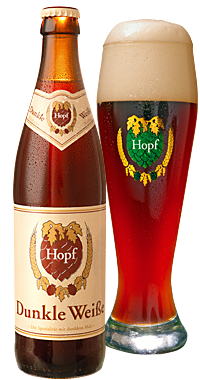 Hopf Dunkle Weisse ABV: 5%
Origin: Miesbach, Bayern, Germany
Website: www.hopfweisse.de
First published: 8 January 2001
Another review from the archive written for the pioneering Oxford Bottled Beer Database (OBBD). I’ve left it uncorrected — so please read it in that historical spirit. Brewery and beer are still very much around.
A well-regarded example of a Bavarian dark wheat beer from a speciality brewer near the Tegernesee. The beer has a luscious deep brown colour and pours with a great head that lingers throughout, its aroma intense with the scents of dried banana, pears and cinnamonish spiciness. The palate is very full, becoming toffeeish and fudgy as it settles, with fruity banana and deliciously warming spice still present.
Despite the apparent aptness of the brewer’s family name, the beer, as appropriate for the style, is not particularly hoppy, but instead beautifully balanced, with a nice dryness lifting the fruity body just enough, and then lingering in pleasingly tangy finish. Well worth sampling as a great example of the style.
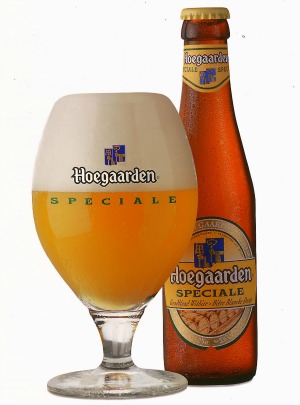 Hoegaarden Spéciale ABV: 6.5%
Origin: Hoegaarden, Vlaams-Brabant, Flanders
Website: hoegaarden.com
First published: 8 January 2001
Another review from the archive written for the pioneering Oxford Bottled Beer Database (OBBD). I’ve left it uncorrected — so please read it in that historical spirit. Hoegaarden Spéciale is still occasionally obtainable as a winter special, but you won’t read much about it or the other older-established brand extensions on the official website these days, just the Radler and various fruited versions.
This seasonal variation on a theme is the most recent addition to the range built around the famous spiced wheat beer from Brabant. Intended as a winter alternative, it’s still a bottle-conditioned wheat beer but it has more barley malt in proportion to unmalted wheat than its world-famous stablemate, and some of this is crystal malt, giving the result less wheat character and more of the sturdy body of a conventional ale.
It’s brewed to a slightly higher gravity, and the spicing seems much more restrained but whether this is because there are less spices or because the extra maltiness obscures them, I couldn’t say for certain. The hops, on the other hand, are more forward. The overall effect is of a considerably more conventional beer, dryer, maltier and with much more subtle hints of wheaty spiciness.
It’s not a bad beer, but in context it’s difficult to see the point of it: the other beers in the Hoegaarden range, even the easygoing Hougaerdse Das, are at least as characterful as the flagship beer – some of them arguably more so, given the growing blandness of Hoegaarden Wit under the stewardship of Interbrew. This beer, on the other hand, is easily the least characterful of the lot. It’s going to disappoint Hoegaarden fans expecting more of the same, and for those coming to the style for the first time it’ll just muddy the waters, especially given the similarity in labelling.
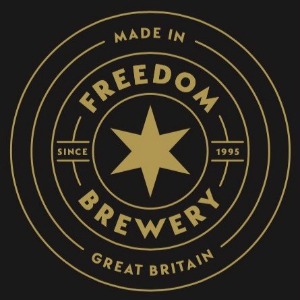 Freedom Brewery, ex-London, now Staffordshire. ABV: 4.4%
Origin: London WC2, England
Website: freedombrewery.com
First published: 8 January 2001
Another review from the archive written for the pioneering Oxford Bottled Beer Database (OBBD). I’ve left it uncorrected — so please read it in that historical spirit.
It’s interesting to look back at this one as the Freedom brewery, founded in 1995, played quite a pivotal role in the development of craft brewing in London and the UK. It was the second brewery, and the first in London, set up with the expertise of Alastair Hook, a rare British champion of proper lager brewing in the post-CAMRA age who went on to found Meantime.
As stated in the article, the production brewery was in Fulham, in fact just off Parsons Green and a stone’s throw from the famous White Horse pub. The Soho Brewing brewpub opened in 1998 at 41 Earlham Street, Covent Garden, originally under separate ownership. Setting aside the sour view of the place I take below, it was also something of a pioneer, as one of the first US-inspired brewpubs in the capital. It was taken over the next year by Freedom and rebranded Freedom Earlham Street but kept the Soho name for some of its brands.
Freedom then went through various ownership changes and soon after this was written, in 2001, it moved out of London. For a while, the beers were brewed at Meantime but later in-house brewing was resumed, and Freedom is still producing ‘craft’ lagers today at Abbots Bromley in Staffordshire. The closest thing to Soho Red among its current repertoire is a US-hopped amber rye lager. Meantime still brews a very decent amber Vienna lager from time to time.
The Earlham Street operation continued as a brewpub, rebranded Zebrano in 2002 and Bünker in 2003, though the new owners’ interest in brewing dwindled and I believe no more beer was produced later than 2005, although the kit remained in place for a while longer. The site is currently a Japanese-themed restaurant by the unfortunate name of Flesh and Buns.
Freedom are best known for their Pilsener, a rare attempt to brew an authentic lager in Britain in the German style and to German standards. This beer, brewed at their Fulham site, is now fairly widely available in the UK with outlets through selected supermarkets and pubs.
The company also owns a rather trendy brewpub in a basement in Covent Garden, also called Freedom Brewery (though also known as the Soho Brewery, rather puzzlingly since it’s not in Soho at all), where a small plant brews a selection of other beers for consumption on the premises, all inspired by continental European and US models. These are all served under gas pressure but are otherwise made to high standards.
Soho Red is described as based on a pre-prohibition US dark beer – a style which, in its turn, owed much to the old Vienna style of dark lager that was brought to North America by European migrants. The relatively modest gravity is more in line with the expectations of contemporary British drinkers but this is still an attractive and flavourful beer, a deep ruby brown in colour with some head.
The nose is fairly restrained, slightly sweet and faintly hoppy, and the beer itself has a pleasant palate, malty but very much in the Germanic style with phenolic notes and some chocolate and fruit. Eventually a herbal bitterness develops and this slightly sweet beer becomes refreshingly grapefruity in the finish.
As beers of this kind are so rare in Britain, this is a welcome addition to the local repertoire — though the pub which is its principal outlet sadly seemed to me too brash, noisy and uncomfortable to enjoy it at its best.
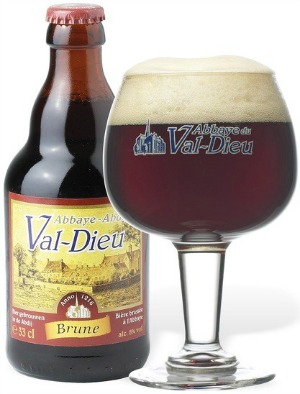 Val Dieu Brune ABV: 6.5%
Origin: Aubel, Liège, Wallonia
Website: valdieu.com
First published: 6 November 2000
Another review from the archive written for the pioneering Oxford Bottled Beer Database (OBBD). I’ve left it uncorrected — so please read it in that historical spirit. This beer is still available, though has had its ABV hiked to 8% since this was written.
One of the unusual micro-brewed specialities at 2000’s Catford Beer Festival, this beer comes from a small scale secular operation in a former monastic brewery at Aubel. It’s a very inviting strong bottle-conditioned abbey brown, with malty aromas, a chocolatey fruit palate with some phenolic complexity, and a brown sugar sweetness balanced by warming alcohol and restrained hops. The lengthy finish is also predominantly sweetish. It’s well made and distinctive, if not particularly distinguished and probably a bit oversweet for some tastes, but at this strength you’re hardly likely to guzzle it in quantity.
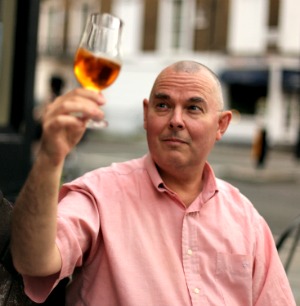 Des de Moor, London, May 2015. Pic: Luke Doyle. I’m a beer writer, tour guide, walk leader, tutored tasting host and Accredited Beer Sommelier based in London.
My latest book is Cask: The real story of Britain’s unique beer culture, published in August 2023. Cask beer is a unique format of fresh, live draught beer that, at its best, delivers a taste experience unmatchable in any other way. My pioneering book, aimed at the discriminating drinker, explains what makes it special, and explores its past, present and future.
I’ve published three editions of London’s Best Beer, Pubs and Bars, the award-winning definitive guide to drinking beer in London. “Probably the best book about beer in London” — Londonist. For more see the London page.
Why not join me on one of my regular brewery heritage walks or tutored tastings. Or I can provide an informal private London heitage pub walk and tasting for your group, or a tasting for your event, alongside various other beer-related services. For more see the Beer Tours page.
I’m a contributor to numerous other books, magazines and websites, including providing the UK listings for The Pocket Beer Book and editing the 2020 edition of Beer in the Netherlands.
Elsewhere on the site are numerous blog posts and beer reviews, many of them archiving material that’s already appeared elsewhere but with some exclusive pieces. Scroll down to see the latest posts, or try these:
I also blog about walking at London underfoot: London’s walking trails under the microscope.
|
Cask  This pioneering new book explains what makes cask beer so special, and explores its past, present and future. Order now from CAMRA Books. Read more here. This pioneering new book explains what makes cask beer so special, and explores its past, present and future. Order now from CAMRA Books. Read more here.
London’s Best Beer  The fully updated 3rd edition of my essential award-winning guide to London’s vibrant beer scene is available now from CAMRA Books. Read more here. The fully updated 3rd edition of my essential award-winning guide to London’s vibrant beer scene is available now from CAMRA Books. Read more here.
|














